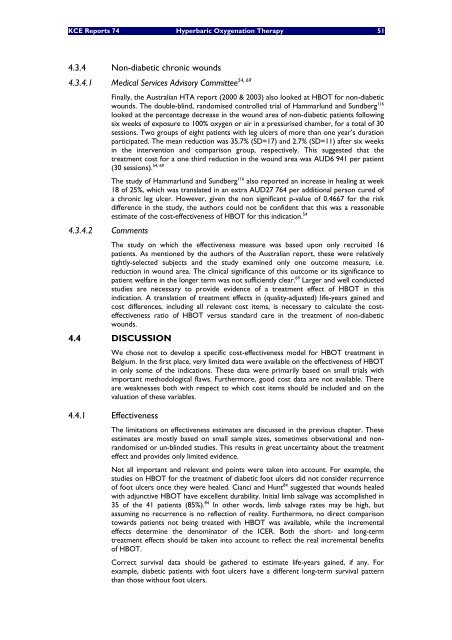Hyperbare Zuurstoftherapie: Rapid Assessment - KCE
Hyperbare Zuurstoftherapie: Rapid Assessment - KCE
Hyperbare Zuurstoftherapie: Rapid Assessment - KCE
You also want an ePaper? Increase the reach of your titles
YUMPU automatically turns print PDFs into web optimized ePapers that Google loves.
<strong>KCE</strong> Reports 74 Hyperbaric Oxygenation Therapy 51<br />
4.3.4 Non-diabetic chronic wounds<br />
4.3.4.1<br />
54, 69<br />
Medical Services Advisory Committee<br />
Finally, the Australian HTA report (2000 & 2003) also looked at HBOT for non-diabetic<br />
wounds. The double-blind, randomised controlled trial of Hammarlund and Sundberg 116<br />
looked at the percentage decrease in the wound area of non-diabetic patients following<br />
six weeks of exposure to 100% oxygen or air in a pressurised chamber, for a total of 30<br />
sessions. Two groups of eight patients with leg ulcers of more than one year’s duration<br />
participated. The mean reduction was 35.7% (SD=17) and 2.7% (SD=11) after six weeks<br />
in the intervention and comparison group, respectively. This suggested that the<br />
treatment cost for a one third reduction in the wound area was AUD6 941 per patient<br />
54, 69<br />
(30 sessions).<br />
The study of Hammarlund and Sundberg 116 also reported an increase in healing at week<br />
18 of 25%, which was translated in an extra AUD27 764 per additional person cured of<br />
a chronic leg ulcer. However, given the non significant p-value of 0.4667 for the risk<br />
difference in the study, the authors could not be confident that this was a reasonable<br />
estimate of the cost-effectiveness of HBOT for this indication. 54<br />
4.3.4.2 Comments<br />
The study on which the effectiveness measure was based upon only recruited 16<br />
patients. As mentioned by the authors of the Australian report, these were relatively<br />
tightly-selected subjects and the study examined only one outcome measure, i.e.<br />
reduction in wound area. The clinical significance of this outcome or its significance to<br />
patient welfare in the longer term was not sufficiently clear. 69 Larger and well conducted<br />
studies are necessary to provide evidence of a treatment effect of HBOT in this<br />
indication. A translation of treatment effects in (quality-adjusted) life-years gained and<br />
cost differences, including all relevant cost items, is necessary to calculate the costeffectiveness<br />
ratio of HBOT versus standard care in the treatment of non-diabetic<br />
wounds.<br />
4.4 DISCUSSION<br />
We chose not to develop a specific cost-effectiveness model for HBOT treatment in<br />
Belgium. In the first place, very limited data were available on the effectiveness of HBOT<br />
in only some of the indications. These data were primarily based on small trials with<br />
important methodological flaws. Furthermore, good cost data are not available. There<br />
are weaknesses both with respect to which cost items should be included and on the<br />
valuation of these variables.<br />
4.4.1 Effectiveness<br />
The limitations on effectiveness estimates are discussed in the previous chapter. These<br />
estimates are mostly based on small sample sizes, sometimes observational and nonrandomised<br />
or un-blinded studies. This results in great uncertainty about the treatment<br />
effect and provides only limited evidence.<br />
Not all important and relevant end points were taken into account. For example, the<br />
studies on HBOT for the treatment of diabetic foot ulcers did not consider recurrence<br />
of foot ulcers once they were healed. Cianci and Hunt 84 suggested that wounds healed<br />
with adjunctive HBOT have excellent durability. Initial limb salvage was accomplished in<br />
35 of the 41 patients (85%). 84 In other words, limb salvage rates may be high, but<br />
assuming no recurrence is no reflection of reality. Furthermore, no direct comparison<br />
towards patients not being treated with HBOT was available, while the incremental<br />
effects determine the denominator of the ICER. Both the short- and long-term<br />
treatment effects should be taken into account to reflect the real incremental benefits<br />
of HBOT.<br />
Correct survival data should be gathered to estimate life-years gained, if any. For<br />
example, diabetic patients with foot ulcers have a different long-term survival pattern<br />
than those without foot ulcers.

















